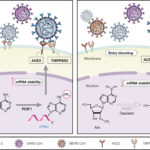2022-10-08 ワシントン州立大学(WSU)
◆ワシントン州立大学ポール・G・アレン・スクール・オブ・グローバル・ヘルスのモハマッド・アミヌル・イスラム助教授が主導したこの研究は、このほど学術誌『PLOS Pathogens』に掲載されました。
◆抗生物質耐性は、世界中で死亡や入院の主な原因の一つとなっています。抗生物質耐性の主な原因は、抗生物質の過剰使用と誤用ですが、重金属などの自然要素も抗生物質耐性を促進する可能性があります。
◆研究者たちは、バングラデシュの2つの農村地域に住む100家族の母親と幼児から水と便のサンプルを採取しました。ハジガンジ地区では、環境中に遍在する有害重金属であるヒ素を高濃度に含む浅い井戸から飲料水を採取していますが、マトラブ地区では、ヒ素を含まない深い井戸から飲料水を採取しています。
◆Hajiganjの50の水サンプルのヒ素濃度の中央値は481マイクログラム/リットル、Matlabの50の水サンプルのヒ素濃度の中央値は0マイクログラム/リットルであった。抗生物質耐性大腸菌の有病率は,Matlabの水(22%)に比べてHajiganjの水(48%)で,Matlabの子ども(76%)に比べてHajiganjの子ども(94%)で有意に高かったが,母親では差がなかった.さらに、Hajiganjの大腸菌は、ペニシリン、セファロスポリン、クロラムフェニコールなどの複数の抗生物質に耐性を持つ割合が高かった。
◆研究者達は、この研究結果が、これが、ヒ素への暴露を減らす努力を倍加することを正当化する、重要な公衆衛生上の懸念であることを示していると書いています。「ヒ素のような重金属は、環境中では抗生物質よりも安定で、より長い期間にわたって細菌に選択的圧力を与え続け、地域社会における抗菌薬耐性の進化と拡大を促進します」とイスラムは述べています。「この現象が、他の交絡因子とは対照的に、観察された高い抗菌剤耐性率をどの程度促進するかは、さらなる研究が必要です。それでも、医療と農業における責任ある抗菌剤の使用とともに、抗菌剤耐性のこの環境要因を抑制することが極めて重要です。
<関連情報>
- https://news.wsu.edu/news/2022/12/08/arsenic-contaminated-water-associated-with-antibiotic-resistance-in-children/
- https://journals.plos.org/plospathogens/article?id=10.1371/journal.ppat.1010952
バングラデシュ農村部におけるヒ素への慢性的曝露が抗生物質耐性大腸菌の糞便担体に及ぼす影響 Effects of chronic exposure to arsenic on the fecal carriage of antibiotic-resistant Escherichia coli among people in rural Bangladesh
Mohammed Badrul Amin ,Prabhat Kumar Talukdar ,Muhammad Asaduzzaman,Subarna Roy,Brandon M. Flatgard,Md. Rayhanul Islam,Sumita Rani Saha,Zahid Hayat Mahmud,Tala Navab-Daneshmand,Molly L. Kile,Karen Levy,Timothy R. Julian,Mohammad Aminul Islam
PLOS Pathogens Published: December 8, 2022
DOI:https://doi.org/10.1371/journal.ppat.1010952
Abstract
Antibiotic resistance is a leading cause of hospitalization and death worldwide. Heavy metals such as arsenic have been shown to drive co-selection of antibiotic resistance, suggesting arsenic-contaminated drinking water is a risk factor for antibiotic resistance carriage. This study aimed to determine the prevalence and abundance of antibiotic-resistant Escherichia coli (AR-Ec) among people and drinking water in high (Hajiganj, >100 μg/L) and low arsenic-contaminated (Matlab, <20 μg/L) areas in Bangladesh. Drinking water and stool from mothers and their children (<1 year) were collected from 50 households per area. AR-Ec was detected via selective culture plating and isolates were tested for antibiotic resistance, arsenic resistance, and diarrheagenic genes by PCR. Whole-genome sequencing (WGS) analysis was done for 30 E. coli isolates from 10 households. Prevalence of AR-Ec was significantly higher in water in Hajiganj (48%) compared to water in Matlab (22%, p <0.05) and among children in Hajiganj (94%) compared to children in Matlab (76%, p <0.05), but not among mothers. A significantly higher proportion of E. coli isolates from Hajiganj were multidrug-resistant (83%) compared to isolates from Matlab (71%, p <0.05). Co-resistance to arsenic and multiple antibiotics (MAR index >0.2) was observed in a higher proportion of water (78%) and child stool (100%) isolates in Hajiganj than in water (57%) and children (89%) in Matlab (p <0.05). The odds of arsenic-resistant bacteria being resistant to third-generation cephalosporin antibiotics were higher compared to arsenic-sensitive bacteria (odds ratios, OR 1.2–7.0, p <0.01). WGS-based phylogenetic analysis of E. coli isolates did not reveal any clustering based on arsenic exposure and no significant difference in resistome was found among the isolates between the two areas. The positive association detected between arsenic exposure and antibiotic resistance carriage among children in arsenic-affected areas in Bangladesh is an important public health concern that warrants redoubling efforts to reduce arsenic exposure.
Author summary
Antibiotic resistance is one of the leading causes of death and hospitalization worldwide. While the major drivers of antibiotic resistance are the overuse and misuse of antibiotics, natural elements such as heavy metals can also promote antibiotic resistance. In this observational study, we investigated the prevalence and abundance of antibiotic-resistant bacteria in drinking water samples and among mothers and children from the same households in two rural areas of Bangladesh with high and low levels of arsenic contamination in drinking water. We found that the prevalence of antibiotic-resistant E. coli was significantly higher in water and among children in high arsenic-contaminated areas compared to the low arsenic-contaminated areas. We also found that a higher proportion of E. coli isolates from the high arsenic area were resistant to multiple antibiotics including penicillin, cephalosporin, and chloramphenicol. Arsenic-resistant bacteria are more likely to be resistant to certain groups of antibiotics, including third-generation cephalosporins. Overall, this study suggests that arsenic exposure could be an important risk factor for the carriage of antibiotic-resistant organisms which needs to be taken into consideration when designing community-based interventions to combat antimicrobial resistance.


